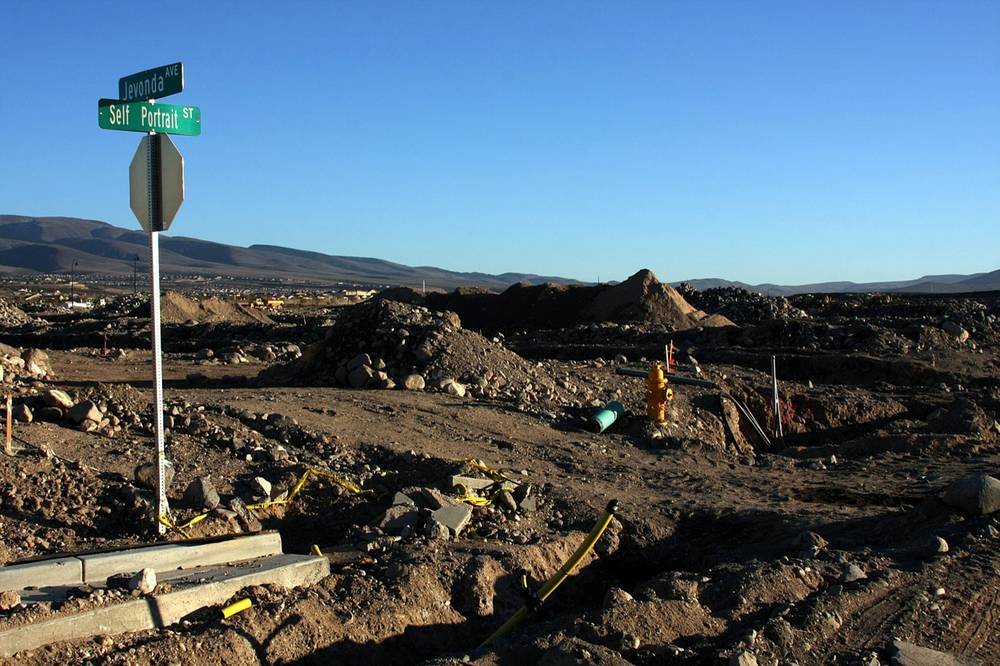There is construction at Inspirada, the massive master-planned community in the southern reaches of Henderson, tucked behind the Henderson Airport. Several homes are going up, and the neighborhood is full of bulldozers, Port-a-Potties and bundles of wood marked “Inspirada.”
But most of the land on the 2,000-acre site is vacant dirt, awaiting construction, waiting for the recession to pass, and on this chilly Sunday, with NFL football games on, it’s very quiet. People are home but don’t want to come to the door. (“We’re not interested! We’re trying to watch the game!”) The scene creates an odd visual congruence: an echo of Vegas’ business-as-usual building boom, with the kind of empty, lonely grandeur you might see on old blocks in Detroit or Chicago, where a lone house guards an otherwise decimated block.
More
- From the Archives
- Perception and Panic! (11/6/08)
- Beyond the Weekly
- Inspirada
- What does 2009 have in store for Henderson? (Las Vegas Sun, 1/2/09)
Since its groundbreaking in 2005, Inspirada, developed by Focus Property Group, has been meant to epitomize intelligent “new urban” suburban. Garages face the alley instead of the street. Little parks abound. The building style owes more to the generous porches of an arts-and-crafts bungalow than the sedate stucco faux-Mediterranean look that dominates much of the city.
The promised town retail, restaurants and office buildings may be years away, but people are still moving in. Keith Neuhart moved from Orange County to Henderson with his wife in November. Their home is at the edge of development at Inspirada. He stares out at the rocky fields where the rest of Inspirada may one day rise. But workers, he says, are busy. “They’re constantly working every day. There’s always movement and machinery.”
Nevertheless, the residential home-builder industry has been particularly hard hit in the last year. “Things stand very poorly,” says Monica Caruso of the Southern Nevada Homebuilders Association. “This is more than a slowdown coming from the boom. The home-building industry is on hiatus in Southern Nevada.”
How bad is it? According to Caruso, at the end of last year there were more than 40 home builders working in the Valley—the association defines a home builder as any person or company who builds five or more homes a year. This was down from a historic high of 179 home builders in 1996. The number of subcontractors has seen a similarly sharp decline.
“At the end of 2008, when the dust settles and the smoke clears, we think there will be about 12 [home builders],” Caruso says. “It’s really a decimated industry.” Some home builders, such as Kimball Hill and Woodside Homes, have declared bankruptcy. Others have pulled back on their construction. One company—Caruso would not say which—has lost more than 90 percent of its staff.
“Las Vegas really grew in 2004 and 2005 and 2006,” notes real estate analyst Ken Perlman, with Sullivan Group Real Estate Advisors. On average, he says, around 20,000 new homes a year were being sold in Vegas in the early years of the decade, peaking at a ridiculous 41,000 in 2005, driven both by easy credit and by speculators. “Las Vegas really stole demand from the future,” he notes.
The future has gotten its own measure of payback. In 2007, new-home sales had fallen to between 15,000 and 16,000. And last year? Through October new-home sales were an anemic 6,300. “Every builder that you talk to is really pulling back and looking for projects in ‘A’ locations,” says Perlman. “If it’s not in a great location, fantastic product, and right price point they’re just not going to build it.”
Perlman says analysts are looking for reduction in the supply of bank-owned homes, a reduction in new-home inventory and price stability as signs the housing market is working itself out. “We still haven’t seen the prize stabilization yet, and we haven’t seen a reduction in real estate-owned inventory.” (The median price on detached homes is down 21 percent between October 2007 and October 2008.)
Don’t look for quick recovery until 2010, and even then it may be modest. Still, for Perlman the fundamentals of the city—including its low cost of living relative to Southern California—are sound. That is if Vegas, and the rest of the country, has learned its lesson.
“The age of excess in 2004-06, those days are over,” says Dennis Smith, president of Home Builders Research. “They will never return.” We’ll see.








Previous Discussion: